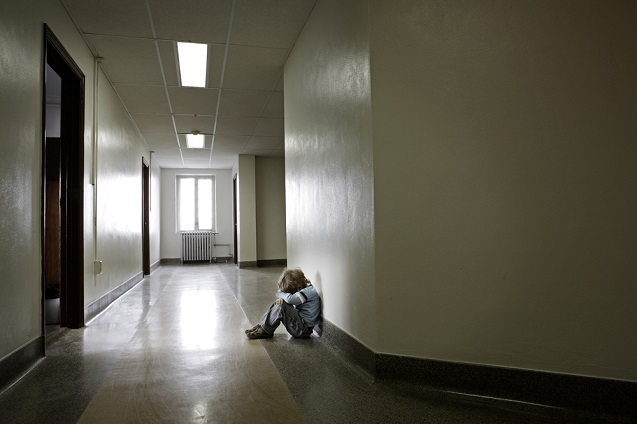
In March 2012, police responded to a call from a Brooklyn public school about a five-year old autistic boy who was having a tantrum. Officers held down the kindergartener, who was then tied to a stretcher and transported to a hospital.
The little boy’s mother had been called to the school and witnessed the episode. “He was crying and screaming,” she said. “They strapped him to that stretcher.”
The episode got local news coverage. And the family eventually filed a lawsuit, which New York settled. But according to the figures that New York files with the federal government, the incident never happened.
Like all school districts across the country, New York is required to record every time a public school kid is held or tied down and report totals each year to the U.S. Department of Education. The number New York gave the government? Zero.
“There’s not even a remote possibility that the number zero is correct,” said Johanna Miller, the advocacy director for the New York Civil Liberties Union.
New York, the nation’s largest school district, wasn’t the only one to incorrectly report zero restraints to the federal government. So did Los Angeles and Chicago – the nation’s second and third largest school districts.
Indeed, Chicago Public Schools spokeswoman Lauren Huffman acknowledged restraints are allowed in some cases but said Chicago doesn’t keep a tally of them. “It’s our intention to do a better job tracking them centrally,” she said.
Earlier this year, ProPublica detailed how kids are frequently restrained at public schools. As we reported, the government’s first attempt at a nationwide count showed 163,000 instances of restraints in the 2012 school year.
Some schools reported hundreds of restraints, which can include anything from pinning uncooperative children face down on the floor to tying them up with straps, handcuffs or even duct tape. Three-quarters of students who were restrained had physical, emotional or intellectual disabilities.
Children have suffered countless injuries from restraints, including broken bones. A government report a few years ago detailed hundreds of instances of abuse and several deaths over two decades.
After that report, the U.S. Department of Education’s Office for Civil Rights made it mandatory for school districts to tell to the government how many times they have used restraints.
The Department of Education declined to say whether they have penalized any districts for failing to report.
But underreporting appears to be rampant. Our analysis found that more than two-thirds of all school systems reported zero instances of restraining a student or isolating them in so-called “seclusion” rooms.
Many districts are not taking the reporting process seriously, said Claudia Center, a senior attorney for the American Civil Liberties Union.
“I think there needs to be a real cultural shift on restraints,” Center said. “It has been a really common practice in schools for decades. If [schools] had to write down how many times they actually do it, they would have to change what they’re doing.”
A spokesman for the federal Department of Education said if school districts fail to collect data on restraints, the government works with them to construct a plan to improve and could ultimately compel them to report by suspending federal aid until they do.
Huffman, the spokeswoman from Chicago’s public school system, said federal officials haven’t contacted school officials there about their missing data.
Los Angeles Unified School District spokeswoman Gayle Pollard-Terry, said that although the district reported zero instances of restraints, it keeps its own tally of incidents involving disabled children. Advocates say such actions, which are called “behavioral emergency inventions,” often come in the form of restraints. The Los Angeles Unified School District reported 103 interventions during the 2012 school year.
As for New York, the city says it doesn’t count restraints because only police and emergency medical technicians are allowed to do them — a distinction federal authorities say is irrelevant. The U.S. Department of Education says all restraints at a public school are to be reported, no matter who does them.
Previously released city records show New York public schools called emergency medical services more than 3,600 times in one recent year to handle disruptive children. EMS logged each of those calls. But when were restraints used? The records don’t say.
Read more about restraints and seclusions in public schools across the country, who’s fighting federal limits on the practices, and whether your state law says it’s ok to pin down kids in school.
Angry, shocked, overwhelmed? Take action: Support independent media.
We’ve borne witness to a chaotic first few months in Trump’s presidency.
Over the last months, each executive order has delivered shock and bewilderment — a core part of a strategy to make the right-wing turn feel inevitable and overwhelming. But, as organizer Sandra Avalos implored us to remember in Truthout last November, “Together, we are more powerful than Trump.”
Indeed, the Trump administration is pushing through executive orders, but — as we’ve reported at Truthout — many are in legal limbo and face court challenges from unions and civil rights groups. Efforts to quash anti-racist teaching and DEI programs are stalled by education faculty, staff, and students refusing to comply. And communities across the country are coming together to raise the alarm on ICE raids, inform neighbors of their civil rights, and protect each other in moving shows of solidarity.
It will be a long fight ahead. And as nonprofit movement media, Truthout plans to be there documenting and uplifting resistance.
As we undertake this life-sustaining work, we appeal for your support. Please, if you find value in what we do, join our community of sustainers by making a monthly or one-time gift.